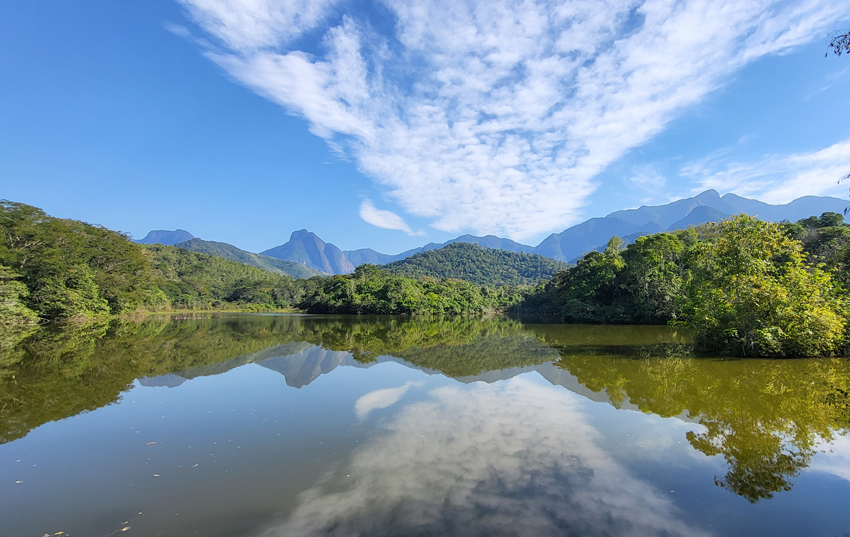By Dan Bradbury, Director of Brand & Communications
In July 2025, I had the privilege of visiting the Reserva Ecológica de Guapiaçu (REGUA). Nestled in the heart of Brazil’s Atlantic Forest, this remarkable reserve spans over 11,000 hectares (27,181 acres), and gave me my first opportunity to experience a project I’ve heard so much about over my 12 years at World Land Trust (WLT). My visit offered a firsthand look at the scale, ambition, and impact of REGUA’s work, and left me inspired by what’s possible when conservation is driven by an unwavering vision.
A Landscape Transformed
From the moment I arrived, the transformation of the landscape was striking. REGUA’s reforestation efforts have been nothing short of extraordinary, with over 500,000 native trees planted to date. The forests surrounding the lodge and wetlands are only around 20 years old yet appeared mature and thriving. These efforts have restored connectivity between fragmented forest patches and created habitat for countless species.
The wetlands near the lodges, more managed in appearance, felt very reminiscent of reserves I visit in the UK, rich with wildlife and teeming with life. They are a testament to REGUA’s long-term ecological restoration strategy, which began in the early 2000s. By reversing drainage systems and rehabilitating degraded lowlands, REGUA recreated vital wetland environments that now support high biodiversity.
Conservation in Action
Over the course of six days, I explored various parts of the reserve, followed many of its trails, and visited the waterfalls hidden deep within the surrounding forest. What was especially rewarding though, was seeing areas I’ve heard so much about and played a part in helping to protect over the years. Namely, the Matumbo Gap and the Cozzolino extension which was acquired in 2024 with support from WLT. Each site highlighted REGUA’s strategic approach to land acquisition and habitat protection. The reserve plays a vital role in safeguarding the Guapiaçu watershed, which remains approximately 60% forested and supports several endangered species. This work is particularly urgent given that the Atlantic Forest, once stretching along Brazil’s coastline, has lost over 93% of its original extent. REGUA’s efforts are helping to protect and restore one of the world’s most threatened and biodiverse ecosystems.
Wildlife Wonders
REGUA’s biodiversity is staggering. Guided walks along the trails revealed an incredible array of birdlife, many of them new to me. The most memorable has to be the White-bearded Manakin (Manacus manacus). This small, energetic bird is a true showman of the Atlantic Forest, known for its striking appearance and even more striking behaviour.
A showman of the Atlantic Forest – A male White-bearded Manakin perches on a branch. Credit: ©Shutterstock/Chelsea Sampson
Males are easily recognised by their jet-black bodies contrasted with a bright white “beard” of feathers under the chin, hence the name. But it’s not just their looks that make them stand out. During the breeding season, these birds put on elaborate courtship displays in small clearings on the forest floor, known as leks. With a series of rapid-fire wing snaps, hops, and buzzes, they perform for females in a kind of avian dance-off. It’s a spectacle of sound and movement that’s as fascinating as it is flamboyant.
We also saw Capybara (Hydrochaeris hydrochaeris), Broad-snouted Caiman (Caiman latirostris), Brown-throated Three-toed Sloth (Bradypus variegatus) and Lowland tapir (Tapirus terrestris), a species that is part of a reintroduction programme at the reserve.
A group of Capybara keeping a wary eye on a Broad-snouted Caiman in the wetlands of REGUA. Credit: ©WLT/Scott Guiver.
Night walks added another dimension, with sightings of three owl species. Tropical Screech Owl (Megascops choliba), Tawny-browed Owl (Pulsatrix koeniswaldiana) and Ferruginous Pygmy Owl (Glaucidium brasilianum) The full species list recorded during the visit includes over 160 bird species, showcasing the incredible ecological richness of the reserve.
Reflections
Throughout the visit, it became clear what an important role WLT has been in REGUA’s success. Nicholas Locke, CEO at REGUA Brazil, spoke with a deep appreciation for the longstanding partnership, and it was personally rewarding to witness the tangible outcomes of WLT’s support on the ground. My time at REGUA was deeply inspiring, it reaffirmed the value of long-term collaboration, the transformative power of ecological restoration, and the importance of strategic land acquisition. REGUA is not just a reserve; it’s a living example of what’s possible when conservation is done right. And none of this would be possible without the generosity and commitment of donors. In Brazil and other areas where we work your support is helping to protect and restore some of the world’s most threatened ecosystems, and REGUA stands as a testament to what we can achieve together.
You too can make a difference at REGUA by supporting reforestation through WLT’s Plant a Tree programme. Every tree planted helps restore the Atlantic Forest and protect the incredible biodiversity that calls it home.
Hit the button below to donate and Plant a Tree today.
Read more…
WLT’s Plant a Tree programme
WLT partner: REGUA
WLT’s projects in Brazil

